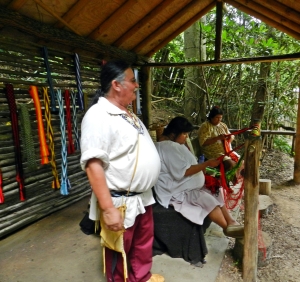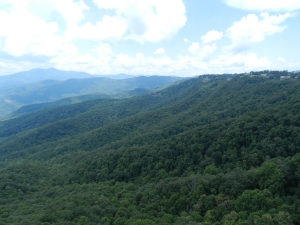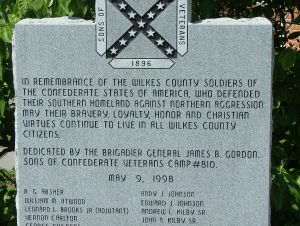A little background of the area
The last part of this article, "Tourist in Dooley land" has been moved to an article of it's own, and this article will be expanded in the near future.
This article should probably have been brought as the first one, but unfortunately I hadn't written it yet when I started the Tom Dooley pages. The idea is to give a brief description of the history, geography and natural beauty of the country, where the Dooley story took place. This article completes with a short guide on how to locate the actual places connected to the story.
The events referred to in these pages took place in the small town, or rather settlement Elkville in the years just after the Civil War. Elkville was and is near present day Ferguson in the western part of North Carolina in the United States, approximately 175 miles west of Raleigh, the state capital and about 40 miles from the Tennessee border, using present day roads.
The Europeans come to North Carolina
The first Europeans came to what
later became known as North Carolina, around 1567. This first colonists were
Spaniards lead by Juan Pardo. They built a fort near the present city of
Morganton in the western part of the state, about 30 miles southwest of
Elkville. Later they buildt five addititional forts, but the small force of only
120 Spaniards were probably to few to man all six forts, because 18 months later
all of the Spaniards who manned the six forts had been killed by local natives.
Queen Elizabeth the First granted Sir Walter Raleigh rights to some land in what
is now the northern part of the state. Here Raleigh tried to establish colonies
at the end of 1580s, but none of them survived. Around 1650 colonists moved
south from Virginia to what would later become the Eastern North Carolina, and
the English king, Charles the 2nd gave permission to found a new colony, which
was named The Province of Carolina, taking its name after the Latin name of the
king, Carolus. In 1729 after a prolonged turmoil, this colony was divided in two, so-called "royal
colonies" , North Carolina and South Carolina.
In the middle of the 1700s, the number of immigrants in the area grew
considerably. Not least Englishmen, Scots, Irish and Germans settled in the area,
but also people from other nations. When the American Revolutionary War broke
out, the colonists in North Carolina supported the uprising, although only 7,800
men joined the rebel army under General Washington. This was the smallest
force relative to the population of any of the 13 rebellious colonies. About
10,000 more enlisted in various local militias.
When the revolution was over many people from North Carolina moved into what is
now called Tennessee, an area for which North Carolina claimed the right. On
21st of November 1789 North Carolina joined the Union as the twelfth of the
thirteen former colonies. At the same time the colony transferred the rights to
the so-called Washington Territory (present day Tennessee) to the federal
government.
Native Americans
When the whites came to
Carolina, the area had already been inhabited by Native Americans for many
thousands of years. When the Europeans began to settle in the area, it was
already inhabited by a number of tribes, that only a few Europeans if any (and
maybe even some Americans) have never heard of. These tribes belonged to three
different language families, which meant that languages were interrelated in
the language familiy, while languages across language families had nothing to
do with each other. This indicates, that the tribes were not related cross
language families, and they did spend a lot of time making war on each other,
sometimes allying themselves with former enemies, to fight former friends and so
on.
 Cherokees
showing how the tribe used to weave. Picture is from the Ocanaluftee Indian
Village in Cherokee, North Carolina.
Cherokees
showing how the tribe used to weave. Picture is from the Ocanaluftee Indian
Village in Cherokee, North Carolina.
In the coastal area lived
members of the Algonquian language families with tribal names like Chowanoke,
Pamlico, Coree and Machapunga. In the southeastern part of the area lived Siouan
spekaing tribes like the Sheraw, Caponi and Catawba and further inland in the
highlands and mountains lived two Iroquois-speaking tribes, the Cherokees and
Tuscaroras. Later (in the beginning of the 1700s) another Iroquois-speaking
tribe, the Meherrin arrived in the area. The Tuscaroras were allied with the
Meherrins during the so-called Tuscarora War between 1711 and 1715, where the
two tribes fought against the English, Dutch and German colonists in North
Carolina. After the war, many Tuscaroras and Meherrins fled north. Another
language family, The Muscogee, was represented west and south of present day North
Carolina in Alabama and Georgia, western Tennesee and Mississipi. This language
was spoken by the Creeks, Chocktaws, Chickasaws, Alibamu and Miccosucee. The
Creeks used to live in North Carolina as well, but had probably been removed
from the area by the Cherokees.
In the western mountains of North Carolina the Cherokee tribe was dominant. The
tribe, that probably numbered between 50,000 and 75,000 members, when they met
the first whites in 1541, originally controlled an area of more than 135.000
square miles (which would make it the fifth largest state in present day USA
after Alaska, Texas, California and Montana). The area included parts of
eight of today's states, Kentucky, West Virginia, Virginia , North Carolina,
South Carolina, Georgia, Alabama and Tennessee. The Cherokee area in North
Carolina stretched from the Blue Ridge Mountains and Great Smoky Mountains in
the west and well into the Piedmont further east and it was inhabited by the
so-called Middle Cherokee, one of three distinct groups of Cherokees. The two
other groups were the Lower Cherokee, who lived in South Carolina and
Upper or Over Hill Cherokee who lived in the present states of Tennessee and
Kentucky and later also in Georgia and Alabama.
When I go into these details abouth the Cherokees, it is partly because it is
another interest of mine :-), but also because the area where the Dooley story
takes place, had previously been controlled by this particular tribe. The most
important Middle Cherokee town, Kituwa, was about 125 miles southwest of
Elkville. In 1838, most of the Cherokee tribe was removed from the area by the
U.S. military on what later became known as The Trail of Tears. The county still
had a number of old people, who remembered the time, when the Cherokees was
around in numbers, and some may even have taken part in the removal. A few
Cherokees stayed behind in North Carolina, primarily in and around what is today
known as the Qualla Boundary, home of the current Eastern Band of Cherokee
Indians, near the former "capital", Kituwa. In the area around Elkville, there
weren't many Cherokees left in the 1860s if any, but there were around 5-600
Cherokees distributed throughout Wilkes county.
Counties (counties)
Today, North Carolina is divided into 100 counties. A county is an administrative unit, that can be compared to what we in Denmark formerly called "amt".
Originally, there were
not as many counties as there are today, but gradually, as more and more people
entered the area and more and more cities and other settlements arose, these very large counties were split. Some were split once again, then later was
merged with parts of other counties to form new counties. The story of Tom
Dooley mentions four different counties. The murder was committed in Wilkes
County (which gets a section of its own below), not in Iredell as stated on the
homepage of North Carolina State Archives.
Many of those involved in the case lived in Caldwell County and a few in
Watauga County, where two of those involved escaped to after the murder, and Tom
Dooley was convicted and hung in Iredell County. Also, the state capital,
Raleigh, named after Sir Walter, was mentioned in the story, but only because
the state capital was home to the Supreme Court, which dealt with the appeals
that were made during the trial of Tom Dooley.
Iredell County is located south-southeast of Wilkes County and this
county only got included in the case, due to the fact that Tom Dooley's defence
lawyer felt that the case could not get a fair trial in the Wilkes County Court,
and therefore requested a change of venue. The county seat of Iredell County was
and is Statesville, where the trials of Tom Dooley took place. This town was
North Carolina's capital for approx. one month towards the end of The Civil War,
when the government fled from Raleigh, which was threatened by the Union
Army.
 View
of the Blue Ridge Mountains near Blowing Rock in Watauga County.
View
of the Blue Ridge Mountains near Blowing Rock in Watauga County.
Caldwell County is
located southwest of Wilkes County. The county seat is Lenoir, but this town
played no part in the case. Caldwell County was created in 1841 as parts of
Burke County and Wilkes County was separated from these counties and merged to
form the new county. Already in 1847, parts of the new county merged with parts
of Wilkes County and Iredell County to form Alexander County and the following
year Caldwell County again had to abandon territory as part of the county, along
with additional parts of Wilkes County, Ashe County and Yancey County was used
to form Watauga County. These changes of county boundaries meant that many of
the cast of characters of the Dooley case, who previously had all lived in the
southwestern part of Wilkes County, were now living in different counties. Tom
Dooley and Ann Melton and their families still lived in Wilkes County; Pauline
Foster lived in Watauga County, while the victim Laura Foster and Tom's
"nemesis", the witness Elizabeth "Betsy" Scott and his "persecutor" James Isbell
all lived in Caldwell County. We know where most of the involved lived, namely
in the settlements King's Creek and German's Hill in the eastern part of the county,
very close to the Wilkes County border.
Watauga County is located west of Wilkes County and the county seat is
the city Boone. As already mentioned, the county was created in 1849, when most of the main characters were young children. Watauga County
is bordering Tennessee, and it
was through this county that Tom Dooley traveled when he left Elkville after the
murder. It was also here that the key witness for the prosecution, Pauline Foster
lived before she arrived in Elkville. Unfortunately, we do not know today exactly where, but I assume that she
came from a place near the border of Wilkes and Caldwell County, perhaps in the
area called Elk or what was called Stony Fork. Both areas had until the creation
of Watauga County been part of Wilkes County.
Watauga as well as Caldwell and Wilkes counties are located in the eastern part
of the Appalachian Mountains, specifically in the eastern foothills of the Blue
Ridge Mountains.
Wilkes County
Wilkes County currently has about 70,000 inhabitants (2010 census), but in 1866 there were far less, just under 16,000 people. The county seat is Wilkesboro as it was then, and in Wilkesboro the county jail and the courthouse was found as they are today. It was in the old, now demolished courthouse, that the trial against Tom Dooley started. The county was created in 1777 from parts of Washington Territory (now Tennessee) and parts of Surry County. Later the county was repeatedly decimated because parts of it were separated in connection with the creation of other counties. The first time was in 1799, when the northwestern parts of the county was used to form a new county, Ashe County. As already mentioned, the county lost several areas again in 1841, 1847 and in 1849.

The W. Kerr Scott Reservoir on the Yadkin River between Wilkesboro and Ferguson.
The county seat,Wilkesboro, is
situated in a place originally called Keowee in the Cherokee language, which
means Mulberry Field, and on the location on the south side of the Yadkin River,
in which Wilkesboro is nowadays located, was a small Cherokee village. The town
of Wilkesboro was founded in 1800 by the revolutionary general and statesman
William Lenoir. He wouldn't name the city after himself, so he named it after the
county, which in turn was named after John Wilkes, an Englishman who had spoken
the colonial case in the English Parliament. After Lenoir's death, the next major
town along the Yadkin River was named after him instead, and it is the one that
now is the county seat of Caldwell County.
The county is located on the eastern slopes of the Appalachian Mountains in the
foothills of Blue Ridge Mountains. In the western part of the county, mountains
reach up to around 3,900 feet, while it only reaches 1,250 feet in the eastern
part of the county. The county's highest point is Thompkin's Knob, which is
4,078 feets above sea level. The southern county border runs through the Brushy
Mountains, an isolated offshoot of the Blue Ridge Mountains. The highest point
in the Brushy Mountains, Pore's Knob is only approx. 12 miles east of Elkville.
Brushy Mountain is separated from the Blue Ridge Moutains by the Yadkin River,
and it was along its banks and in the mountains or hills surrounding the valley
that the people involved in the case lived.
Despite the fact that the area is quite high by Danish standards, Wilkes County
was considered "lowland" by the residents of Watauga County, which was even
higher in the Blue Ridge Mountains. The highest point in Watauga County,
Calloway Peak is almost 6,000 feet above sea level, and the county seat Boone at
3,300 feet is the highest town with more than 10,000 residents throughout the
eastern United States.
Along the Yadkin River stretches a fertile river valley, which before the Civil
War was home to large plantations run by slave labor. In 1860 the number of
slaves amounted to more than a third of North Carolina's total population of
about 1 million people. The western counties had a relatively smaller slave
population, and Wilkes County counted fewer slaves than most counties with less
than 10 % of the population being slaves. Today the valley is still known for
it's fertility, and while there were previously grown much tobacco in the area,
nowadays more and more vineyards takes over, and the area is also
quite suitable for viticulture.
The American Civil War
In April 1861 the
American Civil War began when the cannons at Fort Johnson near Charleston in
South Carolina opened fire on Union troops at Fort Sumter in Charleston harbor.
The first state that had seceded the Union, was South Carolina, who left
the Union as early as December 20th, 1860. Later several states followed, but
even though North Carolina was one of the so-called slave states, it wasn't
eager to leave the union. Only on May 20th, after President Lincoln had urged
North Carolina to attack it's sister state to the south, the state chose to
leave the Union and as the last state join the "Confederate States of America".
The decision was made only after a referendum, but in spite of the state's
reluctance to leave the Union, North Carolina supplied the largest number of
soldiers to the Confederate Army of all the Confederate States, namely 125,000.
More than 40,000 of these soldiers never returned to their homes, and those who
did not die in the battlefield died from hunger or diseases. Among those who
failed to return home from the war, were Tom Dooley's two brothers, John and
Lenny. Many of those who did return, was marked by the war in the same way as
those who returned from Vietnam. That not all supported the southern cause
though, is shown by the 15,000 men from North Carolina that enlisted in the
Union Army.
It was a soldier from North Carolina who was the Civil War's
first casualty in the Battle of Bethel. In the battles of Gettysburg and
Chickamauga regiments from North Carolina penetrated farthest toward the enemy,
and when the war ended at Appomattox Court House* in April 1865, it was a
regiment from North Carolina who fired the last shot. This has led to the adage:
"First at Bethel, farthest at Gettysburg and Chickamauga and last at
Appomattox."
* Actually the war did not end
at Appomattox. The peace here was only made for the eastern theater. Only on
June 23rd 1865 did the final troops surrender. This was "The First Indian Brigade
of the Army of Trans-Mississippi" commanded by Brigadier Stand Watie, a cherokee
chief and the only native american to acchieve a generals rank.
 The
Civil War is still not forgotten in Wilkes County as the text on this stone from
1998 tells.
The
Civil War is still not forgotten in Wilkes County as the text on this stone from
1998 tells.
When the state had
relatively few slave owners, why did such a large number of residents join the
Confederate army? This may be illustrated very well with what happened in
just Wilkes County. Of the approx. 16,000 inhabitants in the county about 13,000
were white, 250 were so-called free blacks, while 1,300 were slaves. The rest
was mainly Cherokee Indians and immigrated Asians. The number of slaves was
therefore much less compared to the number of whites than in the state as a
whole. Among the Asians, who lived in Wilkes County was the original Siamese
twins, Chang and Eng, who had settled in Wilkesboro in 1839 after having toured
throughout the United States. In Wilkesboro, they opened a general store. They
were not succesful though, so the two brothers moved to Traphill in northern
Wilkes County, where they settled as farmers. They were married to two sisters
Sallie and Adelaide Yates. No one thought that there would be children of these
marriages, but Eng and Sallie had a total of 11 children, while Chang and
Adelaide had 10. The two sisters later fell out, which was hard on Chang and
Eng who had to build two houses. They then spent three days with Sallie and her
children and three days with Adelaide and her children. When this became too
much for them, they went on a tour where they displayed themselves and held
lectures for a year at a time. On these tours, they usually brought along
one or two children each. They both died at 30 minute intervals on January 17th
1884, but I digress.
When the vote on whether North Carolina should secede from the
United States took place in 1861 only 51 voters in Wilkes County (adult white
men - no one else had the right to vote) voted for secession, while 1,891 voted
in favor of remaining in the Union. When the war later broke out, and volunteers
we called for, 358 men from the county volunteered at once and
many more did so later on. One of these first volunteers was James Melton, husband of
Ann Melton. Why is it, that so many volunteered, when they did not want to leave
the Union? This was probably not caused by a desire to preserve slavery. Not many of them owned slaves and
besides, most of the few who did, knew that
the days of slavery were numbered anyway. The reason was rather that most people
had more feelings for their state than they did for the Union, and when the state went to war,
even against other states, they backed it up in full. This can be illustrated
with a few quotes, not from a man from North Carolina, but from Virginia, namely
Robert E. Lee, who was to become Commander of the Confederate army.
When Lee just before the Civil War broke out, was asked by the U.S. Secretary of
War if he would take command of the Union Army, he replied: "With
all my devotion to the Union and the feeling of loyalty and duty of an American
citizen, I have not been able to make up my mind to raise my hand against my
relatives, my children, my home. I have therefore resigned my commission in the
Army, and save in defense of my native State, with the sincere hope that my poor
services may never be needed, I hope I may never be called on to draw my sword..."
The fact that Lee was opposed
to slavery, even though he actually had owned slaves before the war, according
to a statement he made after President Lincoln had issued the so-called 'emancipation
proclamation' in 1863, where he released the slaves in the rebellious
South. On this oaacation Lee said: "So far from engaging in a war to
perpetuate slavery, I am rejoiced that Slavery is abolished. I believe it will
be greatly for the interest of the South. So fully am I satisfied of this that I
would have cheerfully lost all that I have lost by the war, and have suffered
all that I have suffered to have this object attained."
Although Lee was from Virginia, many well known Confederate leaders came from
North Carolina. These include General Braxton Bragg, Maj. Gens Dorsey Pender, DH
Hill and Stephen Ramseur, Brigadier Generals Lewis A. Armistead, Junius Daniel,
J. Johnston Pettigrew and Alfred Scales, as well as many, many others. The
soldiers from North Carolina fought bravely in many battles and was nicknamed
"The Tar Heel Boys" because they stood so firm in many battles, it looked as if
their boot heels were glued to the ground with tar, which, incidentally, was one
of North Carolina's main sources of income. This nickname has since given its
name to the entire state, which today is known as, "The Tar Heel State". Tom
Dooley and many others from the area where he lived, wer among those who
volunteered in the war's first year.
After The Civil War
The time after the Civil War was called "the reconstruction period". This era had actually started already during the Civil War, with the initial thoughts on how to integrate those states that had seceded back into the Union, when the war was over. When President Lincoln was assassinated in April 1865 it had the consequence that the so-called "radical Republicans" took power in Congress, and in contrast to both Lincoln and his successor Andrew Johnson, the radicals wanted to pursue a hard line against the South. The leading Southern politicians were stripped of their powers, and most were arrested and imprisoned in Washington. To avoid complete anarchy, the South were placed under military control. The former Confederate states were divided into five military districts. North and South Carolina accounted for Second Military District, which was under the command of Maj. Gen. Daniel E. Sickles. Sickles was a very controversial person already before and during the Civil War, where he had lost a leg at the Battle of Gettysburg. He ended up being ousted as head of the military district, and later became U.S. ambassador to Spain.
Already in 1862, when Union troops had conquered parts of North Carolina, President Lincoln appointed a military governor. His name was Brigadier Edward Stanly and he only served for about a year, becaused he disagreed with the president, about the emancipation proclamation. Stanly closed two schools for colored children in New Bern and was removed by the president. Stanly by the way was an uncle of confederate brigadier Lewis A. Armistead, and the two of them were born in the same house. In 1866 the president appointed a governor of North Carolina, William Holden, whom therefore was not democratically elected for his first period, and, like the Legislative Assembly, the governor was subject to the head of the military district.
The reconstruction era was characterized by confusion, weak laws, weak authorities and distinct corruption, and political animosities often had strong impact on the decisions taken. It was in this politically unstable period that the case against Tom Dooley took place, and it can not be excluded that politics played a role in the outcome, as I have mentioned in previous articles.
The Nature

The Yadkin River, where it is bridged by NC Road 268 in Ferguson.
The nature around Wilkesboro
and Elkville is characterized by mountains and the Yadkin River. Today the river
is dammed just outside Wilkesboro, which has formed an artificial lake, W. Kerr
Scott Reservoir, but back in 1866 it floated freely towards the Atlantic Ocean
from its source in the Blue Ridge Mountains. The river meanders much and changes
direction several times. From its origin near Blowing Rock it runs due south for
a few miles, then turns sharply left and runs in a north-easterly direction for
many miles before it again turns sharply and runs south once again. The section of
the river between the town of Patterson in Caldwell County and Wilkesboro is
located on the stretch where the river flows to the northeast, and it was here
that the events took place. The valley of the Yadkin River is fertile, but surrounded by
low mountains or hills that is stony and overgrown with shrubs and trees. The
valley along this part of the river is known as "Happy Valley".
Not least on the river's northern side, where most of the people lived, the
hills raises fairly steep from the river valley. Because of the age of the
mountains and the erosion that has taken place, the mountains consist of a
plurality of ridges spaced with low valleys. These ridges and valleys are
typically perpendicular to the river valley, which forms the basis for an lot of
smaller streams flowing from the hills into the Yadkin River. Among these
streams are Elk Creek, which in 1866 formed the county line between Wilkes
County and Caldwell County. Today, the border is approx. half a mile further
west on the other side of a ridge. Another of these small streams are Reedy
Branch east of Elk Creek, along which, small farms were situated. Barely a mile
and a half north of the river extends a ridge, that is roughly parallel to the
river. On the north side of this ridge runs Gladys Fork Road and it was near
this road that did not exist in 1866, that Laura Foster was murdered.
The whole district and the rest of the Blue Ridge Mountains is a very scenic
area, if one likes winters with snow, summers, where the mountains are covered
by fog or haze and autumn, when foliage gives the landscape some amazing colors.